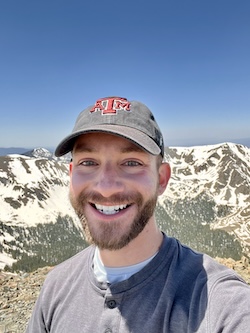Dylan R. Schlichting

TA-03 123, Los Alamos National Laboratory
Los Alamos, NM 87545
Welcome! I’m a postdoc at Los Alamos National Laboratory (LANL) in the Fluid Dynamics and Solid Mechanics Group. I use high-resolution numerical models to study small-scale dynamics in the coastal ocean. I’m part of the SEAHORÇE Project, which seeks to improve the representation of coastal dynamics in the Energy Exascale Earth System Model. I work with with Drs. Mark Petersen, Katherine Smith, and Rob Hetland.
I finished my PhD in the Oceanography Department at Texas A&M University under Dr. Hetland in Summer 2024. My research at TAMU focused on characterizing mixing processes within the estuary-river plume continuum. I spent several years thinking about numerical mixing, a type of spurious mixing that arises in ocean models as a consequence of representing the bulk transport of tracers by currents with discrete approximations. We looked at numerical mixing in idealized and realistic numerical simulations of the Texas-Louisiana (TXLA) shelf in the northern Gulf of Mexico. As part of my postdoc, we are currently implementing a new algorithm for quantifying numerical mixing in the Model for Prediction Across Scales-Ocean, the ocean component of E3SM. We are currently seeking two upper-level undergraduate or graduate students for the 2024 summer LANL parallel computing workshop.
Here is a link to my CV.
Research Interests
- Numerical/spurious mixing
- Coastal ocean submesoscale processes
- Water mass transformation techniques
- Estuarine exchange flow and mixing
- Open science
Education
- PhD. Oceanography, Texas A&M University, (Aug. 2024)
- B.S. Civil Engineering, University of Maine, (Dec. 2019)
- Minor in Mathematics
Publications
-
Wei Hsu, F., Schlichting, D., Shearman, R.K., Nash, J.D., Kobashi, D., Hetland, R.D. Near-Resonance between Shelf Ocean and Semidiurnal Atmospheric Tidal Wind. Journal of Physical Oceanography. In revison.
-
Schlichting, D., Hetland, R., \& Jones, C.S. Numerical mixing suppresses submesoscale baroclinic instabilities over sloping bathymetry. Journal of Advances in Modeling Earth Systems, 16, e2024MS004321. https://doi.org/10.1029/2024MS004321.
-
Schlichting, D., Qu, L., Kobashi, D, and Hetland, R. D. (2023). Quantification of physical and numerical mixing in a coastal ocean model using salinity variance budgets. Journal of Advances in Modeling Earth Systems, 15, e2022MS003380. https://doi.org/10.1029/2022MS003380.
-
Qu, L., Hetland, R. D., & Schlichting, D. (2022). Mixing pathways in simple box models. Journal of Physical Oceanography. https://doi.org/10.1175/JPO-D-22-0074.1.
-
Spicer, P., Schlichting, D., Huguenard, K., Roche, A., and Rickard, L. (2021). Sensing Storm Surge: A framework for establishing a citizen scientist monitored water level network. Ocean and Coastal Management, 211, 105802. https://doi.org/10.1016/j.ocecoaman.2021.105802.
Personal Interests
Outside of work, I enjoy running, hiking, and strength training. Since I moved to New Mexico, I spend most of my free time outdoors. See the photo gallery page for some pictures I’ve accumulated over the years.